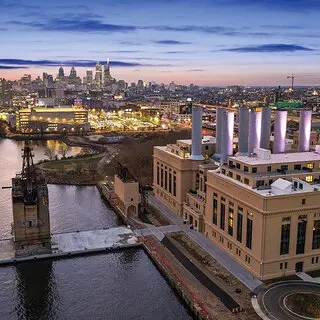
The 2025 Winners of the Richard H. Driehaus Foundation National Preservation Awards
Each winner of this year’s Richard H. Driehaus Foundation National Preservation Awards contributes in some way to strengthening its community. Lawson House provides affordable supportive housing in Chicago; Orange Mound Library and Genealogy Center helps fill a hunger for knowledge and family roots in Memphis, Tennessee; and The Battery in Philadelphia (shown at top) turned an eyesore into a thriving mixed-use development.
Awards jurors Sharon C. Park, a preservation architect and associate director emerita at the Smithsonian Institution; Elisa Hernández Skaggs, an architect and associate principal at Page & Turnbull; and Tya Winn, a design advocate and executive director of Philadelphia’s Community Design Collaborative, pored over many worthy projects to arrive at the final three winners. Below, we bring you a closer look at each place.
Orange Mound Library and Genealogy Center
Memphis, Tennessee
Growing up in the Orange Mound neighborhood of Memphis, Tennessee, in the 1970s, Denise Williams Greene remembers going to all kinds of events at the community’s Melrose High School. There were neighborhood meetings, Friday night football games, homecoming pageants, the annual coronation of Ms. Melrose. “Melrose High was the hub,” she says. “It was just a part of living in Orange Mound.”
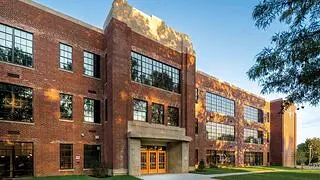
photo by: Joe Luther Photography
The project team repointed and cleaned the brick-and-concrete exterior.
But after a new school building opened in 1972, the three-story redbrick structure, built in 1938 as part of the Public Works Administration, was eventually abandoned and left to deteriorate. “It became an eyesore for the community,” says Greene, who serves as president of the Melrose High School Alumni Association.
Over the ensuing years there was frequent talk of repurposing or demolishing the school, which was placed on the National Register in 2001. Finally, in 2021, the city earmarked $10 million to help kick off rehabilitation efforts.
Following a series of community meetings, a group that included city officials, school alumni, and residents ultimately decided on transforming the high school into the Orange Mound Library and Genealogy Center, which opened to the public in April 2024 after a $17 million rehabilitation. The top two floors of the building will be converted into 24 affordable apartments for people over 62.
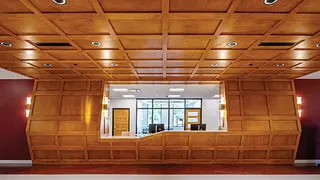
photo by: Joe Luther Photography
The new reception desk.
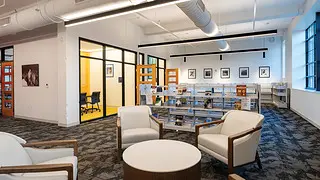
photo by: Joe Luther Photography
The genealogy center provides places to research and gather.
“We listened to a lot of ideas, and one of the things [residents] were very insistent upon was that the community would still be able to experience the building,” says Jimmie Tucker, managing principal of Self+Tucker Architects.
Incredibly, the project marks the first public library for Orange Mound, established in the 1890s as the nation’s first subdivision founded by African Americans for African Americans. A genealogy center made perfect sense for “The Mound,” as many families can trace their histories to the neighborhood’s earliest days. The center contains old photographs and other resources for helping locals discover family roots.
“I was just really impressed that the community was so involved in the reuse of this building,” says juror Elisa Hernández Skaggs, an architect and associate principal with Page & Turnbull. “One thing that many communities take for granted is the local library, and this building was able to provide the first for [Orange Mound]. It basically says that this community is worth it, that its residents matter.”
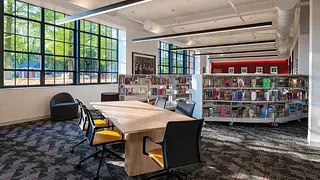
photo by: Joe Luther Photography
New, historically accurate windows let light into the library.
According to Tucker, the building’s sturdy exterior had weathered the elements comparatively well, but its interior had deteriorated badly, and much of it had to be gutted. He and his team designed the new space to reflect the school’s history.
A “historic corridor” runs the length of the first floor, connecting the library to the genealogy center. Schoolhouse-style light fixtures and reproductions of the 1938 paneled doors help echo the building’s past. A sprawling wooden reception desk was inspired by the wainscoting, doors, and transoms from the original classrooms. Maroon and gold accents throughout reflect the school colors.
In November 2023, Tucker led an alumni preview of the building during construction. At the event, he recalls the group spontaneously singing their alma mater. “For somebody to walk in and start singing the school song in the building where you went to school, that just shows a real connection,” he says. “It’s a love for your experience. … It gave me chills.”
—Joe Sugarman
Stay connected with us via email. Sign up today.
Lawson House
Chicago
Following a 28-month retrofit and restoration, Lawson House reopened in 2024 as one of the last bastions of affordable housing in Chicago’s wealthy Gold Coast neighborhood. The 24-story, 250,000-square-foot Art Deco tower designed by Perkins, Chatten & Hammond opened in 1931 as the YMCA of Metropolitan Chicago’s administrative headquarters, but it also provided supportive housing for recent transplants to an industrializing urban center. Along with athletic facilities and community amenities, it contained 583 single-room occupancy (SRO) units.
As decades passed, the building fell into disrepair, though it did continue to house individuals with extremely low incomes. When the YMCA decided to relocate, it sold Lawson House to the nonprofit Holsten Human Capital Development (HHCD) for $1 in 2014 on the condition that the building would remain affordable housing for at least 50 years. “They were absolutely thrilled that we were not going to come in and make it market-rate housing or commercial,” says Jackie Holsten, executive director and board chair at HHCD. Holsten also serves as senior vice president and general counsel at Holsten Real Estate Development Corporation (HREDC), which co-owns Lawson House. Her husband, Peter, is the founder and president of HREDC.
Awards juror Sharon C. Park, a preservation architect and associate director emerita at the Smithsonian Institution, praises the owners’ commitment to preserve “the building’s original use and not gentrify it. … The vision was remarkable.”

photo by: Ross Floyd
Lawson House’s rehabilitated chapel.
While Farr Associates Architecture and Urban Design drew up rehabilitation plans, the Holstens secured financing for the $130 million project. Some of the many funding sources included Low-Income Housing Tax Credits; federal and state historic tax credits; loans from the Illinois Housing Development Authority (IHDA) and the city as part of a U.S. Department of Housing and Urban Development (HUD) program; an IHDA/HUD risk-share mortgage; donations from the developer of the neighboring One Chicago project in accordance with Chicago’s Affordable Requirements Ordinance; and an energy efficiency grant from ComEd. Ryan LLC managed the historic tax credit process.
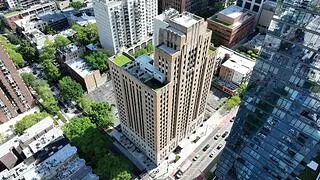
photo by: Walsh Construction
Repointing and repairs brought back the exterior to its original splendor.
HHCD temporarily relocated more than 300 residents during construction. Farr Associates reconfigured the SROs into 409 units, each with its own kitchenette and bathroom. The team restored historical elements such as a five-story travertine stair with an ornate aluminum handrail. A rehabilitated chapel contains 22 hand-painted gambrel-ceiling panels re-created by local artists. Other areas were adapted for modern uses, like the natatorium-turned-event space, which integrates Art Deco motifs with new tiles that recall former swimming lanes. New systems, improved insulation, and energy-efficient windows are expected to reduce Lawson House’s electrical and water bills by 37 percent.
HHCD and Renaissance Social Services provide residents with wraparound social services, such as job training and cooking and cleaning classes. “This project has so many ‘good heart’ aspects,” Park says.

photo by: Ross Floyd
The Vitrolite-walled barbershop is now a laundry room.
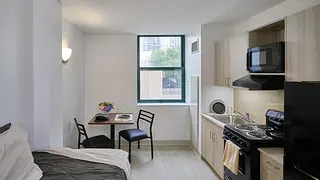
photo by: Ross Floyd
Residential units feature durable materials.
Officials from cities nationwide have visited Lawson House “because they’re interested to see if this is going to fail,” Holsten wryly notes. “And it only fails if you build it and walk away from it. You have to build it and stay.”
—Wanda Lau
The Battery
Philadelphia
When architect Christopher Kenney first toured the remains of the Philadelphia Electric Company’s Delaware Station in 2018, he quickly realized this hulking structure would not be a typical adaptive reuse project. “The building, the entire site, was really just a machine,” says Kenney, a principal at Strada Architecture. “If you’re a developer or architect, the question was, ‘How are you going to take this massive industrial object and turn it into something that can be inhabited by people? And as a preservation exercise, keep it true to what it once was?’”

photo by: Jeffrey Totaro
A communal space inside The Battery.
Completed in 1923, the Delaware Station was one of three company-run coal-fired plants along the Delaware River that provided electricity for the city of Philadelphia. The 128,881-square-foot, Beaux-Arts facility was partially closed by 1969 and fully decommissioned by 2008. It consisted of three main areas: two massive boiler houses, each containing 12 four-story brick boilers where coal dust was burned; a turbine hall; and a switch house used to help distribute electricity. By the time Kenney saw the complex, it was a wreck: Trees were growing on the roof, rusted rebar poked out of the crumbling concrete exterior, fish swam in the turbine room where conduits met the river.
Working with developer Lubert-Adler (also known as LA Partners) and preservation consultant Powers & Company, Kenney and his team created a plan to transform the structure into a development dubbed The Battery, containing 130 market-rate apartments, two hotels, office space, an event venue, and a fitness club.
But first, crews needed to transform the machine into habitable space.
Teams from Fastrack Construction gutted the boiler houses and installed four floors above the first two levels, plus a two-story rooftop addition, set back in order to preserve historic views from street level. They replaced dozens of broken windows with historically accurate ones—some as large as 11 feet wide by 33 feet high. Masons restored exterior cornices and dentils and patched the failing concrete. Inside, concrete walls and columns, metal catwalks, and a 13-foot-tall cistern reflect the building’s past. Meanwhile, eight lucky apartment dwellers can lounge on decks inside their own personal 80-foot-tall smokestacks.
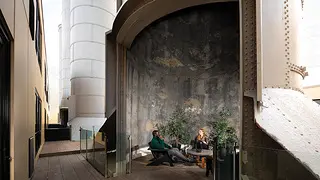
photo by: Powers & Company
Smokestacks now serve as private decks.

photo by: Jeffrey Totaro
The Battery’s massive, historically accurate windows.
The ground and second floors of the switch house were transformed into the event venue, topped by a new 45-unit hotel featuring industrial accents throughout. Meanwhile, the fitness club will occupy the turbine hall when it opens this fall, helping to preserve the open feel of the vast space now stripped of its enormous turbines.
The roughly $220 million, 550,000-square-foot project, which was ongoing as of press time, was financed in part with about $29 million in federal historic tax credits supported by the National Trust Community Investment Corporation.
“This was really an amazing project,” says juror Elisa Hernández Skaggs of Page & Turnbull. “I was so impressed with how they integrated this very monumental building that had an obsolete use and transformed it into something that can live on while retaining its character-defining features. Folks that live there are going to understand that this building once powered the city. … If you can take something like this—a very industrial building—and transform it into something where people can live and play, that is just such a feat."
—Joe Sugarman
Donate Today to Help Save the Places Where Our History Happened.
Donate to the National Trust for Historic Preservation today and you'll help preserve places that tell our stories, reflect our culture, and shape our shared American experience.


